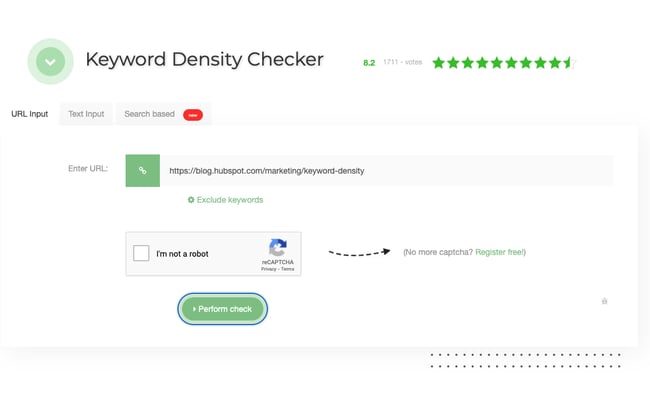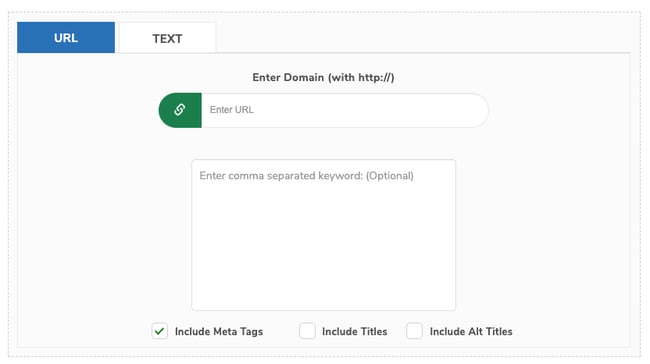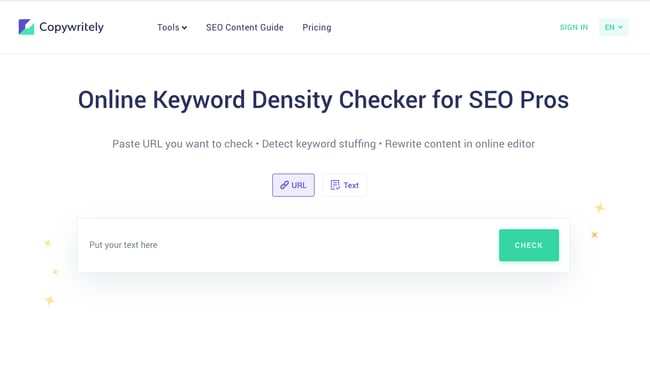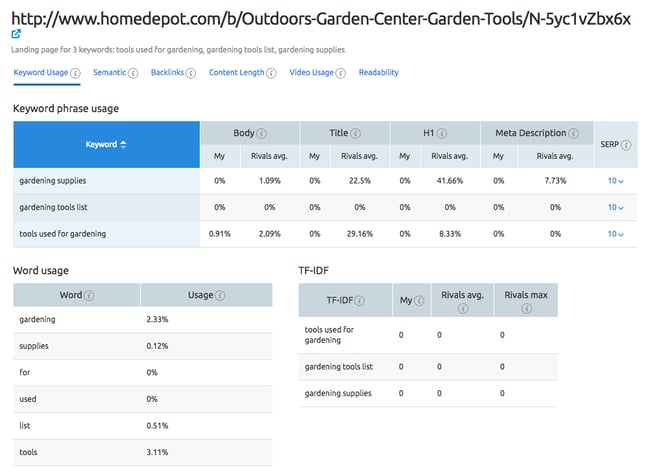When you’re writing SEO-optimized content, how many keywords are enough? How many are too many? How do you know? And what happens if Google and other search engines determine your site is "stuffed" with keywords?
In our beginner's guide to keyword density, we'll cover the basics, dig into why it matters, and offer functional formulas and simple tools that can make sure your keyword strategies are working as intended.
Why Keyword Density Matters
Keywords are a critical part of your SEO strategy .
Along with relevant content and optimized website design, ranking for the right keywords helps your site stand out from the crowd — and get closer to the top of search engine results pages (SERPs).
So it's no surprise that a substantial amount of SEO advice centers on keywords: Doing your research can help you select and rank for top-performing keywords in your market, in turn boosting user engagement and increasing total sales.
Why? Because keywords drive searches. When users go looking for products or services, they'll typically use a keyword that reflects their general intent, and expect search engines to serve up relevant results.
While tools like Google now take into account factors such as geographical area and page
authority — defined in part by the number of visitors to your webpage and in part by "dofollow" links from reputable sites that link back to your page — keywords remain a critical factor in website success.
The caveat? You can't simply "stuff" as many keywords as possible into your content and expect reliable results.
This practice is called keyword stuffing, and it’s a black-hat SEO practice that can lead to penalization and even full-on removal from the SERPs.
During the wild west days of the first search engines, brands and SEO firms would write low-value content and cram it with keywords and keyword tags, along with links to similarly-stuffed pages on the same site. Not surprisingly, visitors grew frustrated and search engine providers realized they needed a better approach.
Now, keyword stuffing has the opposite effect — search engines will penalize the page rankings of sites that still choose to keyword stuff.
By the Numbers: The Keyword Density Formula
How do you calculate keyword density? The formula is straightforward: Divide the number of times a keyword is used on your page by the total number of words on the page.
Here's an easy example: Your page has 1,000 words and your keyword is used 10 times. This gives:
10 / 1000 = .001
Multiply this by 100 to get a percentage, which in this case is 1%.
There's also another formula sometimes used to assess keyword usage: TF-IDF, which stands for "term frequency-inverse document frequency". The idea here is to assess the frequency of a keyword on specific pages (TF) against the number of times this word appears across multiple pages on your site (IDF). The result helps determine how relevant your keyword is for specific pages.
While TF is straightforward, it's easy to get sidetracked by IDF. Here, the goal is to understand the rarity of your keyword across multiple documents. IDF is measured in values between 0 and 1 — the closer to 0, the more a word appears across your pages. The closer to 1, the more it appears on a single page and no others.
This is the "inverse" nature of the calculation: lower values mean more keyword use.
Consider this formula in practice. Applied to very common words such as "the" or "but", the TD-IDF score will approach zero. Applied to a specific keyword, the value should be much closer to 1 — if not, you may need to reconsider your keyword strategy.
What is good keyword density?
While there are no hard and fast rules for keyword density beyond always-relevant "don't keyword stuff" advice, many SEOs recommend using approximately 1-2 keyword for every 100 words of copy. That factors in to about 1-2% keyword density.
Your content may perform similarly with slightly more or slightly less, but general wisdom holds that Google and other search engines respond well to keyword density around 0.5%.
It's also worth remembering the value of keyword variants — words and phrases that are similar, but not identical, to your primary keyword. Let's say your website sells outdoor lighting solutions. While your highest-value keyword for SERPs is "outdoor lighting", stuffing as many uses of this keyword into as many pages as possible will reduce rather than improve overall SEO.
Instead, consider keyword variants; terms that are close to your primary keyword but not an exact copy. In the case of "outdoor lighting", variants such as "garden lighting", "patio lighting", "deck lighting" or "landscape lighting" can help your page rank higher without running afoul of keyword-stuffing rules.
Not sure what variants make the most sense for your website? Use the "searches related to" section at the bottom of Google's SERP for your primary keyword. Here's why: Google has put significant time and effort into understanding intent, so the "searches related to" section will show you similar terms to your primary keyword.
Keyword Density Tools
While you can do the math on keyword density yourself by calculating the total word and keyword counts across every page on your website, this can quickly become time- and resource-intensive as your website expands and page volumes increase.
Keyword density tools help streamline this process. Potential options include:
1. SEO Review Tools Keyword Density Checker

This free tool is browser-based — simply input your site URL or page text, then complete the "I'm not a robot" captcha to perform a keyword density check. While this tool doesn't offer the in-depth analytics of other options on the list, it's a great way to get an overview of current keyword density.
Why We Like It
SEO Review Tool’s keyword density checker includes a color warning for keywords with an abnormally high level of appearance, so you can easily see which ones you need to pare down. It also gives you a breakdown of the keywords by word-number and allows you to exclude certain phrases.
2. SEOBook Keyword Density Analyzer

Similar to the tool above, the SEOBook Keyword Density Analyzer is free — but it does require an account to use. Along with basic keyword density reports, this tool also lets you search for your target keyword in Google, pull data for five of the top-ranked pages using the same keyword, then analyze them to see how your keyword stacks up.
Why We Like It
The SEOBook keyword density analyzer allows you to include meta information and exclude “stop words,” which tend to appear often in a text (like “does,” “a,” “the,” and so forth). You can also set a minimum word length. That gives you the ability to only include words that meet a certain character count criteria.
3. Copywritely Keyword Density Checker

Copywritely’s keyword density checker shows your top keywords by density, and color codes terms that come up often. This tool is a bit more limited than the others in that it doesn’t give you an option to exclude stop words, not does it give you an option to include meta descriptions. But it is a great starter tool.
Why We Like It
Copywritely’s simplicity and user-friendliness makes it a good option if you’re looking for a quick, at-a-glance keyword density check. You then have the option of signing up for a Copywritely account to check and correct errors.
4. Semrush’s On-Page SEO Checker

Semrush’s powerful on-page SEO checker includes a keyword density checker, named “keyword phrase usage” within the tool. Along with keyword density assessment, the tool includes automated SEO checkups and reports, assessments for titles and metadata, backlink prospecting tools, and in-depth site crawls, scans, and reports. It also helps you compare your keyword density with your competition’s. It does come at a premium price, starting at $119.95/month.
Why We Like It
Semrush isn’t just a keyword density checker, but a powerful SEO tool that can help you with all aspects of on-page SEO, including competitive comparison. You can learn how many times competitors user certain keywords. You can then get closer to their performance levels by adhering to the industry standard.
Key(words) to the Kingdom
Want to improve your SERP position and boost site impact? Start with strong keywords.
The caveat? Keyword balance is key to search success. By finding — and regularly assessing — the keyword density of both specific pages and your site at scale, it's possible to boost relevant SEO impact and avoid the ranking pitfalls of overly-dense keyword distribution.
Editor's note: This post was originally published in December 2020 and has been updated for comprehensiveness.
from Marketing https://blog.hubspot.com/marketing/keyword-density
When you’re writing SEO-optimized content, how many keywords are enough? How many are too many? How do you know? And what happens if Google and other search engines determine your site is "stuffed" with keywords?
In our beginner's guide to keyword density, we'll cover the basics, dig into why it matters, and offer functional formulas and simple tools that can make sure your keyword strategies are working as intended.
Why Keyword Density Matters
Keywords are a critical part of your SEO strategy .
Along with relevant content and optimized website design, ranking for the right keywords helps your site stand out from the crowd — and get closer to the top of search engine results pages (SERPs).
So it's no surprise that a substantial amount of SEO advice centers on keywords: Doing your research can help you select and rank for top-performing keywords in your market, in turn boosting user engagement and increasing total sales.
Why? Because keywords drive searches. When users go looking for products or services, they'll typically use a keyword that reflects their general intent, and expect search engines to serve up relevant results.
While tools like Google now take into account factors such as geographical area and page
authority — defined in part by the number of visitors to your webpage and in part by "dofollow" links from reputable sites that link back to your page — keywords remain a critical factor in website success.
The caveat? You can't simply "stuff" as many keywords as possible into your content and expect reliable results.
This practice is called keyword stuffing, and it’s a black-hat SEO practice that can lead to penalization and even full-on removal from the SERPs.
During the wild west days of the first search engines, brands and SEO firms would write low-value content and cram it with keywords and keyword tags, along with links to similarly-stuffed pages on the same site. Not surprisingly, visitors grew frustrated and search engine providers realized they needed a better approach.
Now, keyword stuffing has the opposite effect — search engines will penalize the page rankings of sites that still choose to keyword stuff.
By the Numbers: The Keyword Density Formula
How do you calculate keyword density? The formula is straightforward: Divide the number of times a keyword is used on your page by the total number of words on the page.
Here's an easy example: Your page has 1,000 words and your keyword is used 10 times. This gives:
10 / 1000 = .001
Multiply this by 100 to get a percentage, which in this case is 1%.
There's also another formula sometimes used to assess keyword usage: TF-IDF, which stands for "term frequency-inverse document frequency". The idea here is to assess the frequency of a keyword on specific pages (TF) against the number of times this word appears across multiple pages on your site (IDF). The result helps determine how relevant your keyword is for specific pages.
While TF is straightforward, it's easy to get sidetracked by IDF. Here, the goal is to understand the rarity of your keyword across multiple documents. IDF is measured in values between 0 and 1 — the closer to 0, the more a word appears across your pages. The closer to 1, the more it appears on a single page and no others.
This is the "inverse" nature of the calculation: lower values mean more keyword use.
Consider this formula in practice. Applied to very common words such as "the" or "but", the TD-IDF score will approach zero. Applied to a specific keyword, the value should be much closer to 1 — if not, you may need to reconsider your keyword strategy.
What is good keyword density?
While there are no hard and fast rules for keyword density beyond always-relevant "don't keyword stuff" advice, many SEOs recommend using approximately 1-2 keyword for every 100 words of copy. That factors in to about 1-2% keyword density.
Your content may perform similarly with slightly more or slightly less, but general wisdom holds that Google and other search engines respond well to keyword density around 0.5%.
It's also worth remembering the value of keyword variants — words and phrases that are similar, but not identical, to your primary keyword. Let's say your website sells outdoor lighting solutions. While your highest-value keyword for SERPs is "outdoor lighting", stuffing as many uses of this keyword into as many pages as possible will reduce rather than improve overall SEO.
Instead, consider keyword variants; terms that are close to your primary keyword but not an exact copy. In the case of "outdoor lighting", variants such as "garden lighting", "patio lighting", "deck lighting" or "landscape lighting" can help your page rank higher without running afoul of keyword-stuffing rules.
Not sure what variants make the most sense for your website? Use the "searches related to" section at the bottom of Google's SERP for your primary keyword. Here's why: Google has put significant time and effort into understanding intent, so the "searches related to" section will show you similar terms to your primary keyword.
Keyword Density Tools
While you can do the math on keyword density yourself by calculating the total word and keyword counts across every page on your website, this can quickly become time- and resource-intensive as your website expands and page volumes increase.
Keyword density tools help streamline this process. Potential options include:
1. SEO Review Tools Keyword Density Checker

This free tool is browser-based — simply input your site URL or page text, then complete the "I'm not a robot" captcha to perform a keyword density check. While this tool doesn't offer the in-depth analytics of other options on the list, it's a great way to get an overview of current keyword density.
Why We Like It
SEO Review Tool’s keyword density checker includes a color warning for keywords with an abnormally high level of appearance, so you can easily see which ones you need to pare down. It also gives you a breakdown of the keywords by word-number and allows you to exclude certain phrases.
2. SEOBook Keyword Density Analyzer

Similar to the tool above, the SEOBook Keyword Density Analyzer is free — but it does require an account to use. Along with basic keyword density reports, this tool also lets you search for your target keyword in Google, pull data for five of the top-ranked pages using the same keyword, then analyze them to see how your keyword stacks up.
Why We Like It
The SEOBook keyword density analyzer allows you to include meta information and exclude “stop words,” which tend to appear often in a text (like “does,” “a,” “the,” and so forth). You can also set a minimum word length. That gives you the ability to only include words that meet a certain character count criteria.
3. Copywritely Keyword Density Checker

Copywritely’s keyword density checker shows your top keywords by density, and color codes terms that come up often. This tool is a bit more limited than the others in that it doesn’t give you an option to exclude stop words, not does it give you an option to include meta descriptions. But it is a great starter tool.
Why We Like It
Copywritely’s simplicity and user-friendliness makes it a good option if you’re looking for a quick, at-a-glance keyword density check. You then have the option of signing up for a Copywritely account to check and correct errors.
4. Semrush’s On-Page SEO Checker

Semrush’s powerful on-page SEO checker includes a keyword density checker, named “keyword phrase usage” within the tool. Along with keyword density assessment, the tool includes automated SEO checkups and reports, assessments for titles and metadata, backlink prospecting tools, and in-depth site crawls, scans, and reports. It also helps you compare your keyword density with your competition’s. It does come at a premium price, starting at $119.95/month.
Why We Like It
Semrush isn’t just a keyword density checker, but a powerful SEO tool that can help you with all aspects of on-page SEO, including competitive comparison. You can learn how many times competitors user certain keywords. You can then get closer to their performance levels by adhering to the industry standard.
Key(words) to the Kingdom
Want to improve your SERP position and boost site impact? Start with strong keywords.
The caveat? Keyword balance is key to search success. By finding — and regularly assessing — the keyword density of both specific pages and your site at scale, it's possible to boost relevant SEO impact and avoid the ranking pitfalls of overly-dense keyword distribution.
Editor's note: This post was originally published in December 2020 and has been updated for comprehensiveness.


No hay comentarios:
Publicar un comentario